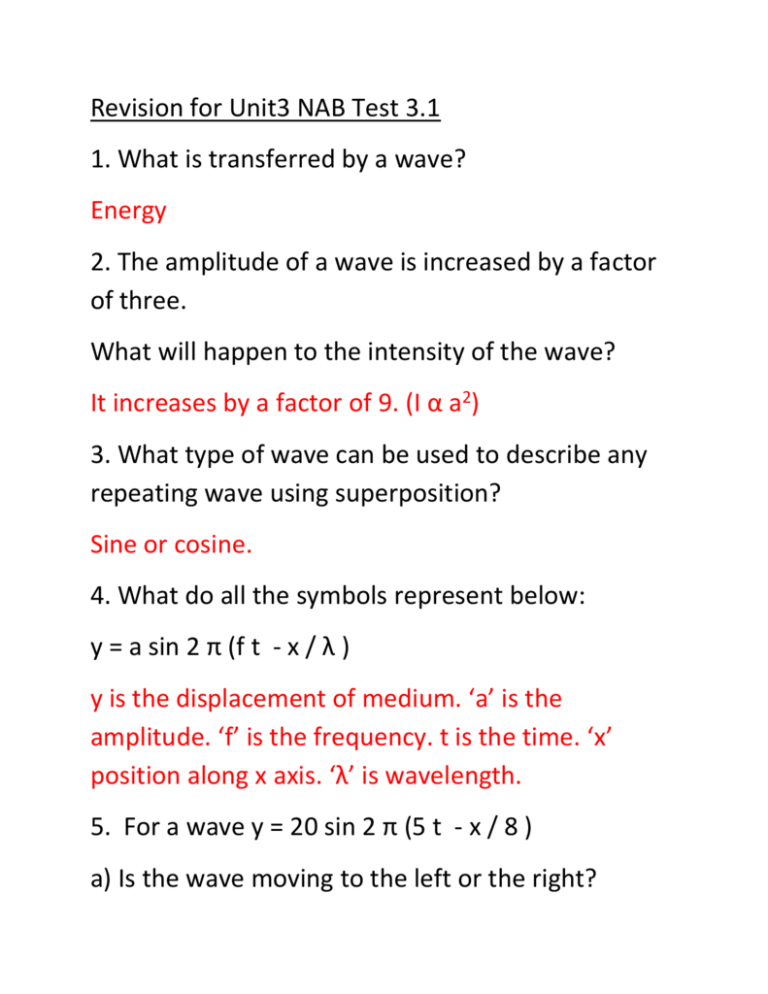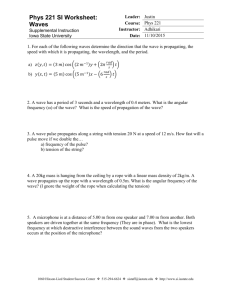Revision Quiz
advertisement

Revision for Unit3 NAB Test 3.1 1. What is transferred by a wave? Energy 2. The amplitude of a wave is increased by a factor of three. What will happen to the intensity of the wave? It increases by a factor of 9. (I α a2) 3. What type of wave can be used to describe any repeating wave using superposition? Sine or cosine. 4. What do all the symbols represent below: y = a sin 2 π (f t - x / λ ) y is the displacement of medium. ‘a’ is the amplitude. ‘f’ is the frequency. t is the time. ‘x’ position along x axis. ‘λ’ is wavelength. 5. For a wave y = 20 sin 2 π (5 t - x / 8 ) a) Is the wave moving to the left or the right? Right b) Calculate the speed of the wave. V = f λ = 5 x 8 = 40 m/s 6. The above wave is moving to the left at 21 m/s. State the wave equation that would describe this wave. (f = v / λ = 21 / 7 = 3 Hz ) Y = 25 cos 2π (3 t + x / 7 ) 7. a) In what type of wave do the particles oscillate at right angles to the direction of travel? Transverse b) What type of wave is a sound wave? Longitudinal 8. What type of wave is produced by the interference of two coherent waves travelling in opposite directions? Standing wave. 9. a) Which points are nodes? X, Z b) Which points are antinodes? W, Y 10. What is the amplitude at a node? Zero 11. Minimum levels of sound are marked with a blue dot. a) Calculate the wavelength of the sound. 20 / 5 = 4m = λ / 2, So λ = 8 m b) Calculate the frequency if v = 340 m/s. f = v / λ = 340 / 8 = 42.5 Hz 12. Points W to Y U to V U to Y V to Y Phase Wavelengths 0.5 0.25 1.0 0.75 Difference Degrees 180 90 360 270 Radians π π/2 2π 3π/2 13. A travelling wave has a wavelength of 40 cm. Calculate the phase difference from the origin to a point 27.6 cm along the wave. Φ / 2π = X / λ Φ / 2π = 27.6 / 40 Φ = 4.34 rad 14. What is the phase difference in radians on the next nearest wave that is “in phase”? 2π rads = 6.28 rad (Two nearest points that are in phase e.g. 1λ) 15. What name is given to the change in frequency when a source is moving relative to an observer? Doppler Effect 16. A siren emits a note at 800 Hz as the ambulance travels away from the observer at 30 m/s. Calculate the frequency heard by the observer. (Speed of sound = 340 m/s) fobs = fs v /( v + vs ) fobs = 800 x 340 /( 340 + 30 ) fobs = 735 Hz 17. A stationary ice-cream van emits a note at 1000 Hz as a car approaches at 20 m/s. Calculate the frequency heard by the car driver. fobs = fs ( v + vo ) / v fobs = 1000 ( 340 + 20 ) / 340 f = 1059 Hz 18. A source of sound waves is moving towards a stationary observer with speed vs. The sound has a frequency of fs and a speed v. Derive an expression for the frequency heard by the observer. λ = v / fs for observer λobs = v / fs – vs / fs = 1/fs ( v – vs) fobs = v / λobs = fs v / ( v - vs) 19. What is required to make two light beams coherent? Same frequency and constant phase difference. 20. Explain why it is difficult to make light waves coherent unlike sound or microwaves. Light is produced by electrons falling in energy level in an atom. This process is spontaneous or random. Different sources will not always be in phase even if they are the same frequency. 21. When light enters glass why do we have to consider the optical path length rather than the actual length? Being optically more dense means that there are n times more wavelengths in the same distance so we must multiply the length by the refractive index. 22. Two coherent light waves of wavelength 500 nm meet after a path difference of 250 nm. Calculate the phase difference. Φ=2πx/λ Φ=2π x 250/500 = π rad. (180°) Out of phase. 23. For a ray of light striking a thin film, where will a phase change of π rad occur? At the point of entering the film (a more optically dense medium). 24. A soap bubble is 1 x 10 -6 m thick with a refractive index of 1.2. For light of wavelength 600 nm will the reflected ray be constructive, destructive or otherwise? 2nt = m λ 2 x 1.2 x 1 x 10 -6 = m x 600 x 10-9 m = 4 (destructive) 25. For a wedge fringe, glass slides of length 8 cm are used with light of wavelength 550 nm. The fringe spacing is calculated to be 2.2 x 10-4 m. Calculate the thickness of a human hair at one end between the slides. ΔX = λL/2D 2.2 x 10-4 = 550 x 10-9 x 0.08 / 2x D D = 0.1 x 10-3 m 26. A camera lens has a coating with n = 1.25 to reduce reflected rays of wavelength 500 nm. Calculate the thickness of this coating. d = λ/4n = 500 x 10-9 / 4 x 1.25 = 1 x 10-7 m 27. Laser light passes through a grating to produce an interference pattern on a screen 8 m away. The grating has 400 lines/mm and between the second order maximum on one side and the other second order maximum measures 8.32 m. a) Calculate the wavelength of light used. ΔX = λD/d d = 1 x 10-3/400 = 2.5 x 10-6 8.32/4= λx 8/2.5 x 10-6 λ = 650 nm b) What type of interference is this? Division of wavefront. 28. Why do some camera lenses have a magenta hue when they reflect white light? The coating can only transmit one wavelength completely. If the green wavelengths are chosen to transmit then red and blue will still reflect to produce magenta. 29. What is polarised light? Light that oscillates in only one plane. 30. Can sound waves be polarised? Explain your answer. No. They are longitudinal. Only transverse waves can be polarised. 31. How would you polarise light? Pass it through a polaroid filter or reflect it off an electrical insulator. Any process that absorbs the vibrations all planes except one. 32. Explain how a combination of “polariser” and “analyser” can prevent the transmission of light. The polariser will allow only light oscillating in one plane to pass through. The second polariser will also allow this light to pass through if it is aligned in the same plane. As the second polariser (the analyser) is rotated it gradually reduces the light level to zero when it is rotated by 90°. 33. Explain how Polaroid glasses can remove glare. Any reflections from an insulating surface are partly polarised. Maximum polarisation occurs at Brewster’s angle, n = tan ip. If the polarised glasses act as an analyser, when rotated at 90° to the first polarising filter the reflected light will not pass through. 34. Complete the diagram below for when ip is equal to Brewster’s angle. 35. Prove n = tan ip n = sin ip / sin r However, r + ip = 90° So, r = 90° - ip n = sin ip / sin (90° - ip) n = sin ip / cos ip = tan ip n = tan ip 36. For water n = 1.33 calculate the polarising angle and the angle of refraction. n = tan ip 1.33 = tan ip ip = 53° r = 90 - 53° = 37°







